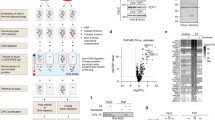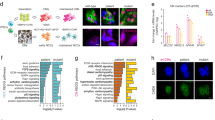Abstract
Cockayne syndrome (CS) is a rare genetic disease characterized by severe growth, mental retardation and pronounced cachexia. CS is most frequently due to mutations in either of two genes, CSB and CSA. Evidence for a role of CSB protein in the repair of oxidative DNA damage has been provided recently. Here, we show that CSA is also involved in the response to oxidative stress. CS-A human primary fibroblasts and keratinocytes showed hypersensitivity to potassium bromate, a specific inducer of oxidative damage. This was associated with inefficient repair of oxidatively induced DNA lesions, namely 8-hydroxyguanine (8-OH-Gua) and (5′S)-8,5′-cyclo 2′-deoxyadenosine. Expression of the wild-type CSA in the CS-A cell line CS3BE significantly decreased the steady-state level of 8-OH-Gua and increased its repair rate following oxidant treatment. CS-A cell extracts showed normal 8-OH-Gua cleavage activity in an in vitro assay, whereas CS-B cell extracts were confirmed to be defective. Our data provide the first in vivo evidence that CSA protein contributes to prevent accumulation of various oxidized DNA bases and underline specific functions of CSB not shared with CSA. These findings support the hypothesis that defective repair of oxidative DNA damage is involved in the clinical features of CS patients.
This is a preview of subscription content, access via your institution
Access options
Subscribe to this journal
Receive 50 print issues and online access
$259.00 per year
only $5.18 per issue
Buy this article
- Purchase on Springer Link
- Instant access to full article PDF
Prices may be subject to local taxes which are calculated during checkout






Similar content being viewed by others
References
Brooks PJ . (2002). DNA repair in neural cells: basic science and clinical implications. Mutat Res 509: 93–108.
Brooks PJ, Wise DS, Berry DA, Kosmoski JV, Smerdon MJ, Somers RL et al. (2000). The oxidative DNA lesion 8,5′-(S)-cyclo-2′-deoxyadenosine is repaired by the nucleotide excision repair pathway and blocks gene expression in mammalian cells. J Biol Chem 275: 22355–22362.
Cappelli E, Degan P, Frosina G . (2000). Efficient repair of 8-oxo-7,8-dihydrodeoxyguanosine in human and hamster xeroderma pigmentosum D cells. Carcinogenesis 21: 1135–1141.
Citterio E, Van Den Boom V, Schnitzler G, Kanaar R, Bonte E, Kingston RE et al. (2000). ATP-dependent chromatin remodeling by the Cockayne syndrome B DNA repair-transcription-coupling factor. Mol Cell Biol 20: 7643–7653.
Degan P, Sancandi M, Zunino A, Ottaggio L, Viaggi S, Cesarone F et al. (2005). Exposure of human lymphocytes and lymphoblastoid cells to simulated microgravity strongly affects energy metabolism and DNA repair. J Cell Biochem 94: 460–469.
D'Errico M, Lemma T, Calcagnile A, Proietti De Santis L, Dogliotti E . (2007). Cell type and DNA damage specific response of human skin cells to environmental agents. Mutat Res 614: 37–47.
D'Errico M, Teson M, Calcagnile A, Nardo T, De Luca N, Lazzari C et al. (2005). Differential role of transcription-coupled repair in UVB-induced response of human fibroblasts and keratinocytes. Cancer Res 65: 432–438.
de Waard H, de Wit J, Andressoo JO, van Oostrom CT, Riis B, Weimann A et al. (2004). Different effects of CSA and CSB deficiency on sensitivity to oxidative DNA damage. Mol Cell Biol 24: 7941–7948.
de Waard H, de Wit J, Gorgels TG, van den Aardweg G, Andressoo JO, Vermeij M et al. (2003). Cell type-specific hypersensitivity to oxidative damage in CSB and XPA mice. DNA Repair (Amsterdam) 2: 13–25.
Dianov G, Bischoff C, Sunesen M, Bohr VA . (1999). Repair of 8-oxoguanine in DNA is deficient in Cockayne syndrome group B cells. Nucleic Acids Res 27: 1365–1368.
Fousteri M, Vermeulen W, van Zeeland AA, Mullenders LH . (2006). Cockayne syndrome A and B proteins differentially regulate recruitment of chromatin remodeling and repair factors to stalled RNA polymerase II in vivo. Mol Cell 23: 471–482.
Groisman R, Polanowska J, Kuraoka I, Sawada J, Saijo M, Drapkin R et al. (2003). The ubiquitin ligase activity in the DDB2 and CSA complexes is differentially regulated by the COP9 signalosome in response to DNA damage. Cell 113: 357–367.
Henning KA, Li L, Iyer N, McDaniel LD, Reagan MS, Legerski R et al. (1995). The Cockayne syndrome group A gene encodes a WD repeat protein that interacts with CSB protein and a subunit of RNA polymerase II TFIIH. Cell 82: 555–564.
Jaruga P, Birincioglu M, Rodriguez H, Dizdaroglu M . (2002). Mass spectrometric assays for the tandem lesion 8,5′-cyclo-2′-deoxyguanosine in mammalian DNA. Biochemistry 41: 3703–3711.
Jaruga P, Theruvathu J, Dizdaroglu M, Brooks PJ . (2004). Complete release of (5′S)-8,5′-cyclo-2′-deoxyadenosine from dinucleotides, oligodeoxynucleotides and DNA, and direct comparison of its levels in cellular DNA with other oxidatively induced DNA lesions. Nucleic Acids Res 32: e87.
Kamiuchi S, Saijo M, Citterio E, de Jager M, Hoeijmakers JH, Tanaka K . (2002). Translocation of Cockayne syndrome group A protein to the nuclear matrix: possible relevance to transcription-coupled DNA repair. Proc Natl Acad Sci USA 99: 201–206.
Kuraoka I, Bender C, Romieu A, Cadet J, Wood RD, Lindahl T . (2000). Removal of oxygen free-radical-induced 5′,8-purine cyclodeoxynucleosides from DNA by the nucleotide excision-repair pathway in human cells. Proc Natl Acad Sci USA 97: 3832–3837.
Kyng KJ, May A, Brosh Jr RM, Cheng WH, Chen C, Becker KG et al. (2003). The transcriptional response after oxidative stress is defective in Cockayne syndrome group B cells. Oncogene 22: 1135–1149.
Laine JP, Egly JM . (2006). When transcription and repair meet: a complex system. Trends Genet 22: 430–436. Epub 2006.
Lehmann AR . (2003). DNA repair-deficient diseases, xeroderma pigmentosum, Cockayne syndrome and trichothiodystrophy. Biochimie 85: 1101–1111.
Licht CL, Stevnsner T, Bohr VA . (2003). Cockayne syndrome group B cellular and biochemical functions. Am J Hum Genet 73: 1217–1239.
McGoldrick JP, Yeh YC, Solomon M, Essigmann JM, Lu AL . (1995). Characterization of a mammalian homolog of the Escherichia coli MutY mismatch repair protein. Mol Cell Biol 15: 989–996.
Nance MA, Berry SA . (1992). Cockayne syndrome: review of 140 cases. Am J Med Genet 42: 68–84.
Newman JC, Bailey AD, Weiner AM . (2006). Cockayne syndrome group B protein (CSB) plays a general role in chromatin maintenance and remodeling. Proc Natl Acad Sci USA 103: 9613–9618.
Osterod M, Larsen E, Le Page F, Hengstler JG, Van Der Horst GT, Boiteux S et al. (2002). A global DNA repair mechanism involving the Cockayne syndrome B (CSB) gene product can prevent the in vivo accumulation of endogenous oxidative DNA base damage. Oncogene 21: 8232–8239.
Proietti-De-Santis L, Drane P, Egly JM . (2006). Cockayne syndrome B protein regulates the transcriptional program after UV irradiation. EMBO J 25: 1915–1923.
Spivak G, Hanawalt PC . (2006). Host cell reactivation of plasmids containing oxidative DNA lesions is defective in Cockayne syndrome but normal in UV-sensitive syndrome fibroblasts. DNA Repair 5: 13–22.
Tuo J, Chen C, Zeng X, Christiansen M, Bohr VA . (2002). Functional crosstalk between hOgg1 and the helicase domain of Cockayne syndrome group B protein. DNA Repair (Amsterdam) 1: 913–927.
Tuo J, Jaruga P, Rodriguez H, Bohr VA, Dizdaroglu M . (2003). Primary fibroblasts of Cockayne syndrome patients are defective in cellular repair of 8-hydroxyguanine and 8-hydroxyadenine resulting from oxidative stress. FASEB J 17: 668–674.
Tuo J, Muftuoglu M, Chen C, Jaruga P, Selzer RR, Brosh Jr RM et al. (2001). The Cockayne Syndrome group B gene product is involved in general genome base excision repair of 8-hydroxyguanine in DNA. J Biol Chem 276: 45772–45779.
Acknowledgements
Grant support: Associazione Italiana per la Ricerca sul Cancro (AIRC), Compagnia di S Paolo (Programma Oncologia) to GF, MIUR/FIRB (RBNE01RNN7, RBIN042YJ7) and Fondazione Cariplo. Certain commercial equipment or materials are identified in this paper to specify adequately the experimental procedure. Such identification does not imply recommendation or endorsement by the National Institute of Standards and Technology, nor does it imply that the materials or equipment identified are necessarily the best available for the purpose.
Author information
Authors and Affiliations
Corresponding author
Rights and permissions
About this article
Cite this article
D'Errico, M., Parlanti, E., Teson, M. et al. The role of CSA in the response to oxidative DNA damage in human cells. Oncogene 26, 4336–4343 (2007). https://doi.org/10.1038/sj.onc.1210232
Received:
Revised:
Accepted:
Published:
Issue Date:
DOI: https://doi.org/10.1038/sj.onc.1210232
Keywords
This article is cited by
-
XPG: a multitasking genome caretaker
Cellular and Molecular Life Sciences (2022)
-
Oxidative and Energy Metabolism as Potential Clues for Clinical Heterogeneity in Nucleotide Excision Repair Disorders
Journal of Investigative Dermatology (2015)
-
Effect of ERCC8 tagSNPs and their association with H. pylori infection, smoking, and alcohol consumption on gastric cancer and atrophic gastritis risk
Tumor Biology (2015)
-
UVSSA and USP7, a new couple in transcription-coupled DNA repair
Chromosoma (2013)
-
Mutations in UVSSA cause UV-sensitive syndrome and destabilize ERCC6 in transcription-coupled DNA repair
Nature Genetics (2012)



